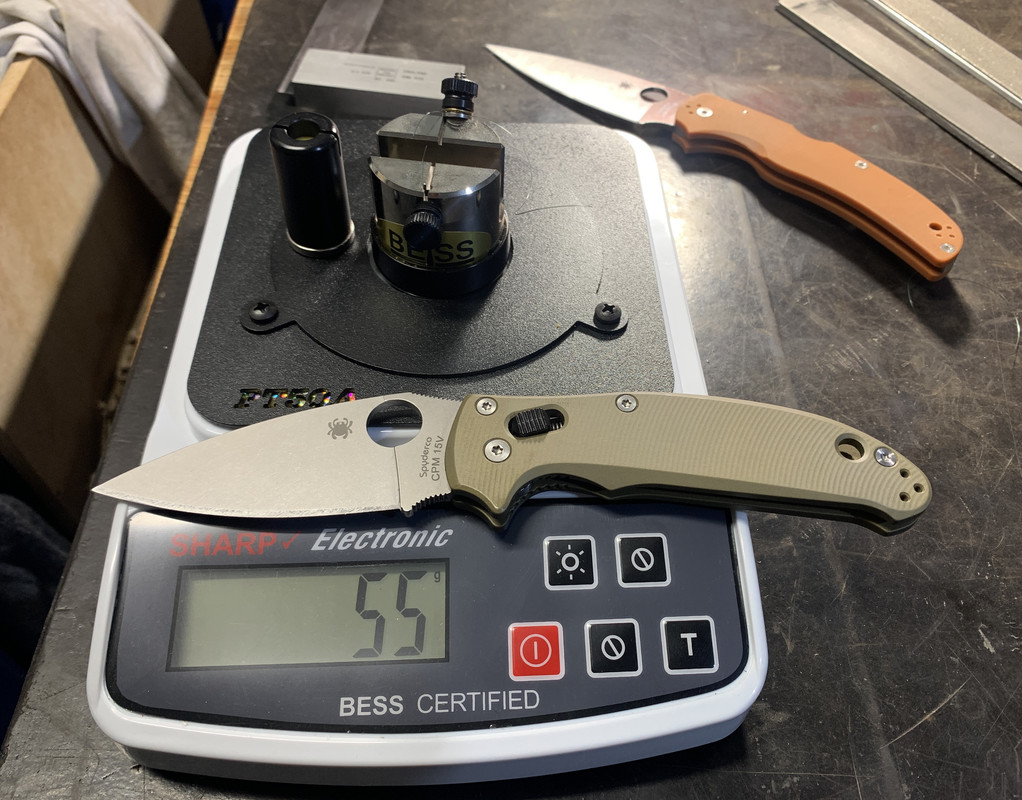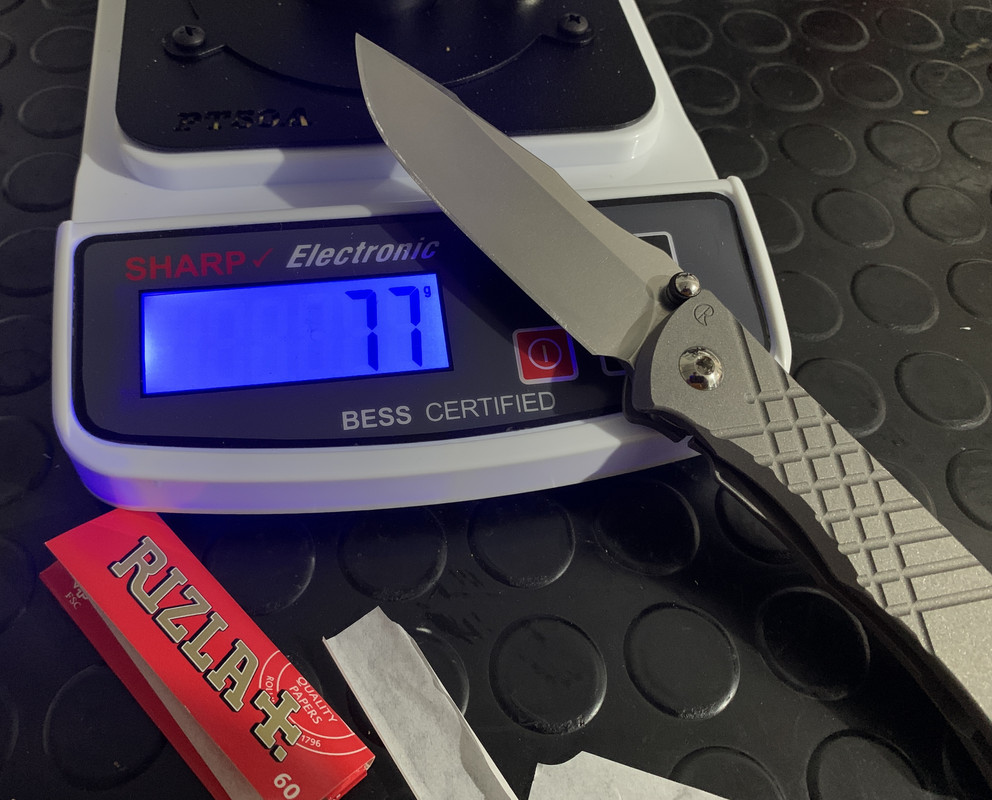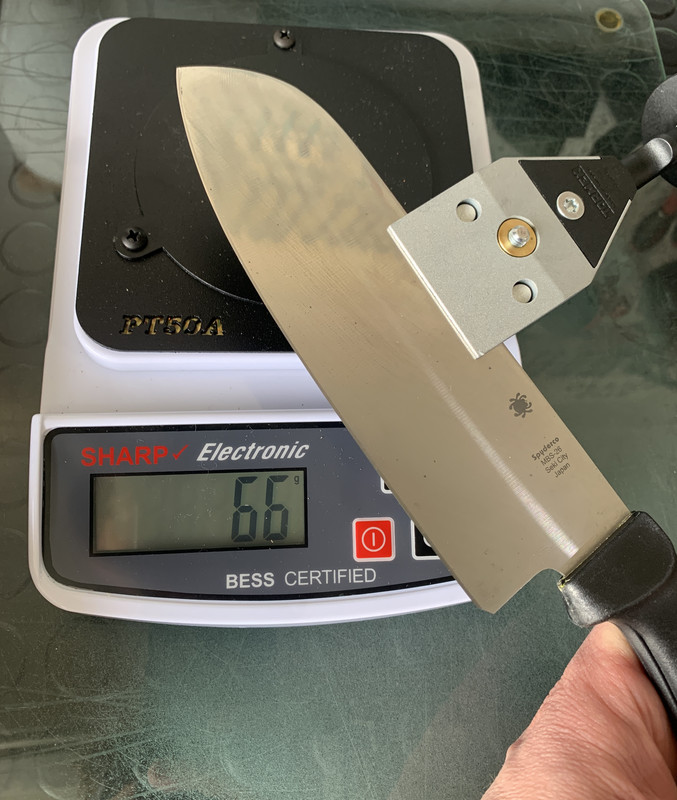Any of you guys have or ever use one of these to check if you have your knife edge honed? Heck all I have is my thumb and hairy arm to check my honed edge, the other thing I like if I am after the sharpest I can get.
I will find some of the lightest weight paper, like Christmas gift wrapping paper, put a lightly loop of about 2" in diameter and just hold that loosely. Forget the slicing at the edge of paper... roll a loop loosely.
Then I see if my knife will slice into this without kinking it or folding the tube inward. You want your knife to slice right in at will. It does that, I am comfortable with my knife being honed...
I just got this email yesterday about these BESS machines that can actively check your edge. It's still early Friday morning here but the coffee is on, you guys stop by here and have a cup lol...
https://worksharptools.com/products/edg ... Q1I.WDhPFT
Sharpness meter, The BESS.
- Brock O Lee
- Member
- Posts: 4099
- Joined: Thu Jul 21, 2011 3:34 am
- Location: Victoria, Australia
Re: Sharpness meter, The BESS.
Hey Jeb, I have one, and I've been using it occasionally over the last 18 months.

The BESS tester tests push-cutting sharpness, at a very specific point on your edge. You normally take a few measurements at different points, and then take an average reading. To get consistent results, you have to cut the filament as slowly as possible. You also have to preload the filament tension each time for consistency when you use the spooled version (easy by hanging a 100g weight on the string during setup). Alternatively, you could use the test clips. They are already pre-tensioned and good to go, but more expensive.
One critique of this machine is that it is easy to "cheat" and get good but fake results. Another is that it does not test slicing sharpness/aggression. You need a fairly refined edge for this machine to be useful IMO. If you like "coarse" edges (I'd say sub-800 grit), then this tester may not be very useful to you.
I typically finish on 1000 grit diamonds, then strop as little as possible on basswood with 1-3 micron diamond spray to deburr. With this finish, if I can score below 100g on the BESS, I know I probably have a clean burr-free edge. Above 120g you still have a burr, or not a refined edge, according to extensive research by Vadim Kraichuk (see below).

To confirm no burr, I also slice thin Rizla cigarette paper over the whole length of the edge. If I get no snags, just a smooth even slice, I know I'm good to go. Any trace of a burr will still snag. These burrs are typically not possible to feel, or see with a bright light.

The tester is especially useful in the beginning when you still develop your own technique, because it gives you a way to verify your progress. After that, I found that I did not use it very often, but it is nice to have around for a quick test. It made me a better sharpener, and especially made me pay more attention to deburring.
Credit to the late Dr Vadim Kraichuk of Aus Knife Grinders. He ran a very successful sharpening business in Aus for many years. He did a lot of experimental work to understand optimal methods for deburring, and verification with BESS and other scientific methods. He shared his findings freely on his YT channel, but also published a booklet on "Knife deburring", on Amazon. He also developed the first CBN wheels for the Tormek, if I'm not mistaken.


The BESS tester tests push-cutting sharpness, at a very specific point on your edge. You normally take a few measurements at different points, and then take an average reading. To get consistent results, you have to cut the filament as slowly as possible. You also have to preload the filament tension each time for consistency when you use the spooled version (easy by hanging a 100g weight on the string during setup). Alternatively, you could use the test clips. They are already pre-tensioned and good to go, but more expensive.
One critique of this machine is that it is easy to "cheat" and get good but fake results. Another is that it does not test slicing sharpness/aggression. You need a fairly refined edge for this machine to be useful IMO. If you like "coarse" edges (I'd say sub-800 grit), then this tester may not be very useful to you.
I typically finish on 1000 grit diamonds, then strop as little as possible on basswood with 1-3 micron diamond spray to deburr. With this finish, if I can score below 100g on the BESS, I know I probably have a clean burr-free edge. Above 120g you still have a burr, or not a refined edge, according to extensive research by Vadim Kraichuk (see below).

To confirm no burr, I also slice thin Rizla cigarette paper over the whole length of the edge. If I get no snags, just a smooth even slice, I know I'm good to go. Any trace of a burr will still snag. These burrs are typically not possible to feel, or see with a bright light.

The tester is especially useful in the beginning when you still develop your own technique, because it gives you a way to verify your progress. After that, I found that I did not use it very often, but it is nice to have around for a quick test. It made me a better sharpener, and especially made me pay more attention to deburring.
Credit to the late Dr Vadim Kraichuk of Aus Knife Grinders. He ran a very successful sharpening business in Aus for many years. He did a lot of experimental work to understand optimal methods for deburring, and verification with BESS and other scientific methods. He shared his findings freely on his YT channel, but also published a booklet on "Knife deburring", on Amazon. He also developed the first CBN wheels for the Tormek, if I'm not mistaken.

Last edited by Brock O Lee on Fri Sep 19, 2025 6:54 am, edited 1 time in total.
Hans
Favourite Spydies: Military S90V, PM2 Cruwear, Siren LC200N, UKPK S110V, Endela Wharncliffe K390
Others: Victorinox Pioneer, CRK: L Sebenza, L Inkosi, Umnumzaan
Favourite Spydies: Military S90V, PM2 Cruwear, Siren LC200N, UKPK S110V, Endela Wharncliffe K390
Others: Victorinox Pioneer, CRK: L Sebenza, L Inkosi, Umnumzaan
Re: Sharpness meter, The BESS.
No, I don't have a BESS tester. The idea intrigued me, though, so I made the filament fixture out of aluminum round stock, borrowed a scale from the kitchen, and experimented with different fishing line until my numbers came close to what I thought the BESS numbers should be.
It was fun exercise both in machining and sharpening. Eventually I got bored with the whole exercise. The scale is back in the kitchen and the aluminum fixture sits here on my desk. I can already tell when my edges are sharp with my arm hair, and that's good enough for me. My tester hasn't been calibrated with a real BESS unit, so I can't compare sharpness with others, but I don't really care that much.
If you're curious and the cost isn't a problem, the BESS tester can be a fun trinket. It can confirm what you already know, and tell you when you're being lazy and need to try harder. The only reason to get the official product is if you're comparing your work to the work of others. If you're just using it to measure your own sharpening technique, you can make a clone using a ten dollar kitchen scale, some fishing line, and a chunk of wood that you can carve with your keenly sharpened Spyderco.
Re: Sharpness meter, The BESS.
Heck I never really gave this sort of thing any thought guys lol. I never knew they had something like this. I was shown way early at a very young age how to check with the thumb as well as dragging the edge over your fingernail and then the arm hair if you were really uncertain.
Later in life I had a guy show me how he used really thin cheap-o wrapping paper and a loose loop and slice into it like a barrel.
When I got this email yesterday, I just never thought anything about something like this and thought well why not, we have testing equipment for everything else.
I live under a rock I guess lol. I don't get out much lol... I just thought I would tack this up on this forum and see, thanks alot for the info shared on this, as I had no idea how it even worked...
Later in life I had a guy show me how he used really thin cheap-o wrapping paper and a loose loop and slice into it like a barrel.
When I got this email yesterday, I just never thought anything about something like this and thought well why not, we have testing equipment for everything else.
I live under a rock I guess lol. I don't get out much lol... I just thought I would tack this up on this forum and see, thanks alot for the info shared on this, as I had no idea how it even worked...
Re: Sharpness meter, The BESS.
This is a critique that comes from people that don't understand how testing works. Any test has a set of parameters that it must be performed within. It would be like criticizing a scale because if you jump up and down on it then the measurement isn't accurate. Yes, there are some people on social media showing unrealistically good results for clout, either on accident or on purpose. But that doesn't mean the test doesn't work.Brock O Lee wrote: ↑Fri Sep 19, 2025 6:24 amOne critique of this machine is that it is easy to "cheat" and get good but fake results.
http://www.KnifeSteelNerds.com - Steel Metallurgy topics related to knives
Re: Sharpness meter, The BESS.
I see this got moved to this off-topic side of the forum, sorry about starting this in the wrong place of the forum. I had thought someone had took the thread down lol...
Re: Sharpness meter, The BESS.
I got one a long time ago when it was the KN100 prototype model.
I have been thinking about picking up one of the newer ones, but what I don't really like is that they have a "home", "pro" and "industrial" model and only the latter measures in better than 5 grams resolution--meaning you won't see a measurement between say 100 and 105. That's fine for benchmarking sharpness levels, I guess, but I really want one to plot BESS score over an amount of work done. For example, seeing how much the BESS score drops per foot of cardboard cut. That way I could compare the ability of different knife configurations to retain their apex radius width.
Well, since I didn't feel like spending $250 on the BESS machine, I devised a test using Q tips instead. The kind with the plastic handles. That way I can measure the force on grams it takes to bissect the Q tip and plot it out in fine grained detail.
I think whether you should get one of the BESS testers depends on whether you want to be able to compare your own results to other's, in which a standardized test protocol and medium is needed. But as you have mentioned, there are many people out there "cheating the test" to try to get the lowest scores possible, so whether your BESS score is really meaningfully comparable to anyone else's will depend on your test protocol being comparable to theirs.
Personally I think if you just want to test your own skills, plot performance, etc. then some kind of DIY solution probably makes more sense. If you want one as a standardized means to compare to others, just be aware that you'll need to ensure they're testing in the same way as you before putting any stock in their numbers.
I have been thinking about picking up one of the newer ones, but what I don't really like is that they have a "home", "pro" and "industrial" model and only the latter measures in better than 5 grams resolution--meaning you won't see a measurement between say 100 and 105. That's fine for benchmarking sharpness levels, I guess, but I really want one to plot BESS score over an amount of work done. For example, seeing how much the BESS score drops per foot of cardboard cut. That way I could compare the ability of different knife configurations to retain their apex radius width.
Well, since I didn't feel like spending $250 on the BESS machine, I devised a test using Q tips instead. The kind with the plastic handles. That way I can measure the force on grams it takes to bissect the Q tip and plot it out in fine grained detail.
I think whether you should get one of the BESS testers depends on whether you want to be able to compare your own results to other's, in which a standardized test protocol and medium is needed. But as you have mentioned, there are many people out there "cheating the test" to try to get the lowest scores possible, so whether your BESS score is really meaningfully comparable to anyone else's will depend on your test protocol being comparable to theirs.
Personally I think if you just want to test your own skills, plot performance, etc. then some kind of DIY solution probably makes more sense. If you want one as a standardized means to compare to others, just be aware that you'll need to ensure they're testing in the same way as you before putting any stock in their numbers.
Re: Sharpness meter, The BESS.
I made one of these myself around 20 years ago with a block of wood, a couple nails, spool of thread and a postal scale.
On my setup average factory edges were around 110-140 grams. Spyderco fsctory edges were around 80 grams. My polished edges,back then, were topping out around 40-60 grams.
It'd be fun to dig around the attic and see if I still have it somewhere. I know I at least have photos on my pc somewhere.
Like some others mentioned, it was fun for a while but even if I found it I doubt I'd use it much these days. Too much hassle.
On my setup average factory edges were around 110-140 grams. Spyderco fsctory edges were around 80 grams. My polished edges,back then, were topping out around 40-60 grams.
It'd be fun to dig around the attic and see if I still have it somewhere. I know I at least have photos on my pc somewhere.
Like some others mentioned, it was fun for a while but even if I found it I doubt I'd use it much these days. Too much hassle.